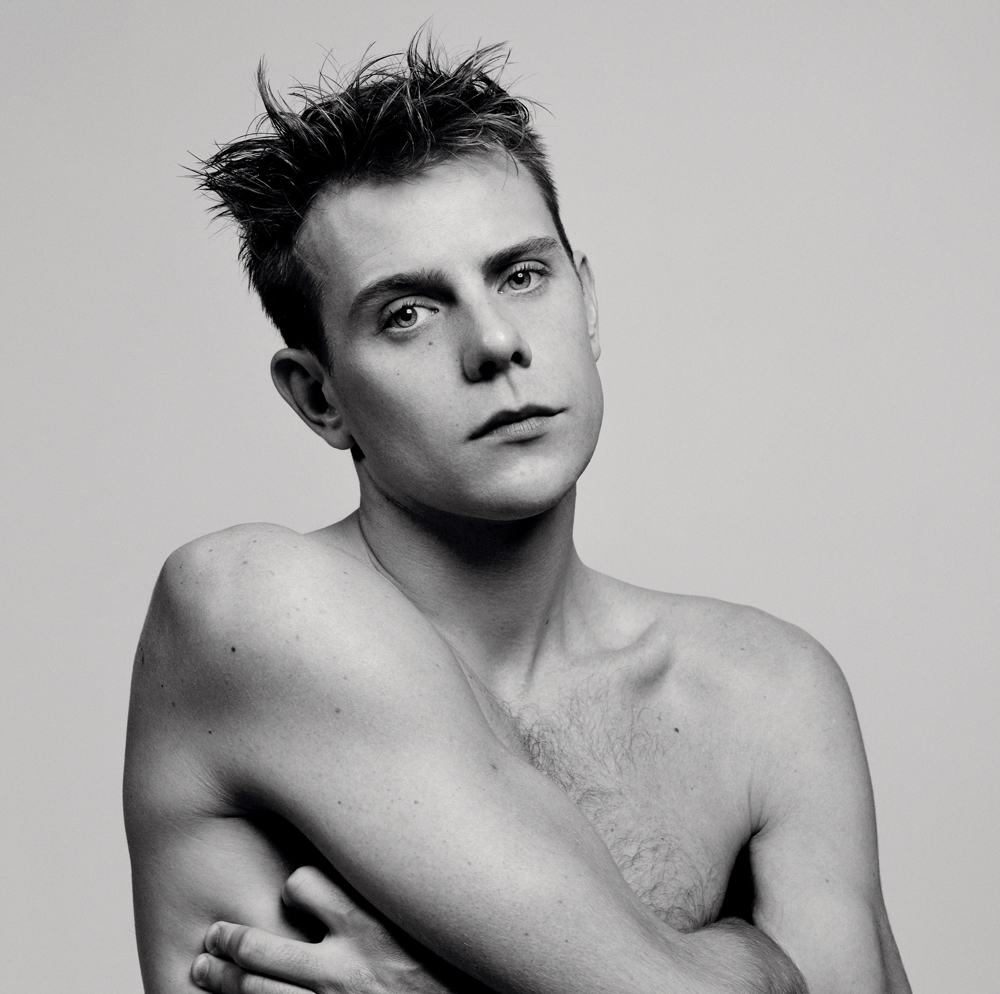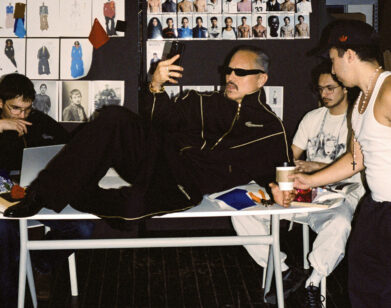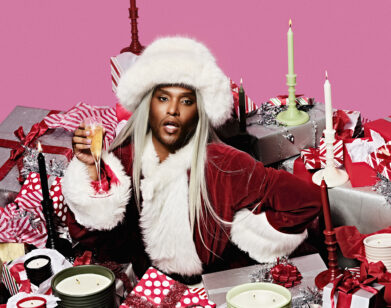Jonathan Anderson
There will always be something that turns me on in the dichotomy between men’s and women’s clothing. Jonathan Anderson
When it was announced in September 2013 that Jonathan Anderson—the young designer of conceptual, unisex-minded London label J.W. Anderson, known for past collections that gleefully upended gender codes (knit crop tops and ruffled bloomers for men; boxy, sculptural silhouettes and sweeping trousers for women)—was to take the reins as creative director of Loewe, the 168-year-old Spanish luxury leather goods house, the entire fashion world took notice. It was validation of the Irish designer’s auspicious talent, giving him a place at the table among the heavyweights of the LVMH empire (namely, Nicolas Ghesquière, Phoebe Philo, and Riccardo Tisci), and it was also a stamp of approval for Anderson’s larger fashion vision, with LVMH simultaneously acquiring a minority stake of his eponymous label.
This past summer—prior to his well-received, breezily sensual womenswear debut at the UNESCO building at Paris Fashion Week in October—Anderson unveiled an all-new Loewe that he re-engineered from the ground up. His new vision for the Loewe house was heralded by an update of the logo by art directors M/M (Paris); a new bag design, the Puzzle; and an inaugural ad campaign that, alongside new images photographed by Steven Meisel, appropriated shots from a 1997 Meisel Italian Vogue editorial featuring Maggie Rizer and Amber Valletta. Loewe’s first U.S. flagship is also slated to open in Miami in early 2015. The campaign, certainly atypical, is an indicator of Anderson’s fashion sensibility—as not just a creator, but as an aggregator and translator of fashion for the image-hungry Instagram generation. As the 30-year-old Anderson explained to his friend, DJ and sound designer Michel Gaubert, during a phone call this past November, fashion is now in the ownerless age of the internet—and he just wants to show us his sketchbook.
JONATHAN ANDERSON: Hey, Michel. Whereabouts in the world are you?
MICHEL GAUBERT: I’m in New York. I’m going to San Francisco this afternoon.
ANDERSON: I’m in Paris—back at work again.
GAUBERT: How do you feel being between London and Paris?
ANDERSON: I feel like I’m always on the Eurostar. [laughs] Years and years ago, I hated Paris because I didn’t know anyone, but now that I spend half my time there and half my time in London, I find there are two aspects of my life. I feel like it’s me having an affair with a country. I’m living in a hotel, but hopefully, by next year, I’ll have an apartment.
GAUBERT: I think a French lover is not a bad thing. [laughs] You often talk to me about your parents. Your parents took you on vacation to Ibiza; your father was in Argentina. Do you speak Spanish from that?
ANDERSON: I unfortunately don’t speak any Spanish at all. When I was younger, we went to Ibiza a lot because my parents bought an apartment there. I feel like that has always stuck with me. My parents are huge influences on me. My mother was an English teacher. My father played professional rugby and coached rugby for the Irish rugby team. He went to Argentina many years ago—it was during the ’80s. He was touring with the Penguins [rugby club].
GAUBERT: When you were a kid, what were you like? What were you into?
ANDERSON: My brother and sister were very sporty. They all did rugby. I was very into performing arts. I went to the National Youth Music Theatre. I was one of those singing, clapping children. When I became a teenager, I got very into clothing. I remember cutting Gucci advertisements and sticking them on my wall. [laughs] My wall used to be covered in advertisements. I remember buying a pair of Gucci jeans.
GAUBERT: Tom Ford, I suppose.
ANDERSON: It was that Tom Ford era. Then as I got older, it was Patrick Cox shoes and Dior Homme. But my access to fashion was actually through an American store called T.J. Maxx. In North Ireland, it’s called T.K. Maxx. I would buy everything that was probably rejected from stores. I remember buying a pair of leopard-print, faux-fur skinny jeans by Jean Paul Gaultier. I got them for, I think, 12 pounds. I never wore them, but they were always there. [laughs]
GAUBERT: I’m a bit of a collector myself so I understand that kind of thing.
ANDERSON: It’s interesting: When I look back at things I’m into today, I always think it’s things between 8 and 15 that influence you the most. Color—I think you learn color when you’re a child.
I don’t see myself as a designer-designer. I’m not an Alaïa. I am fundamentally a creative director. It is about character building in the end. Jonathan Anderson
GAUBERT: But how did you start getting into fashion as a profession?
ANDERSON: I was studying at the Studio Theatre in Washington, D.C., and I started to befriend a guy in the costume department. They had these giant rooms of clothing. I was working on A Midsummer’s Night Dream and became obsessed by the costumes and this idea of characters and clothing. I was very young when I was there. I was obsessed by James Dean: I read the biographies, I bought jeans, I wore white T-shirts, I started smoking. I was mega-influenced by everything.
GAUBERT: Did you have a red leather jacket, too?
ANDERSON: I had a red nylon jacket and red leather jacket—it was pretty tragic. So I ended up dropping out of a three-year course. I went back to Northern Ireland. My parents were very disappointed in the amount of money I had spent and hadn’t actually gotten a degree. I worked in the men’s department in [Irish luxury department store] Brown Thomas to try to earn the money back. When I was there, the Prada team came in and said to me, “You have to meet Manuela Pavesi [Miuccia Prada’s right-hand woman], she will love you. And if you ever come to London, we’ll give you a job.” I thought they were just joking, so I never took them up on it. I ended up applying for all the universities in London to go to fashion school. I did this course at the London College of Fashion for menswear. One day, I walked into Prada and Manuela was there. She said, “When can you start?” and, “Can you do this rack?” So I did the rack, and a week later I was working at the company [as a visual merchandiser] and left university.
GAUBERT: How long did you last there?
ANDERSON: I lasted there two years.
GAUBERT: Oh my God. That’s a long time!
ANDERSON: I learned so much there. She was the most incredible person.
GAUBERT: So what about when Loewe, the big Spanish label, went shopping for you? Was it a big surprise?
ANDERSON: Delphine Arnault and Pierre-Yves Roussel from LVMH approached me to buy part of my own brand [J.W. Anderson]. During the process of that, Delphine and Pierre-Yves said, “Would you be interested in another brand?” Delphine was like, “Why don’t you go to this factory? It’s a brand called Loewe.” And I said, “Sure, why not?” So I remember going to the factory in Spain pretending I was writing for a magazine. Undercover. [Gaubert laughs] I’ll never forget the day I turned up, going into a room filled with all different leathers. I was just like, “This is the brand I want to work for. I hope they give it to me now.” [laughs] I did this book for them, kind of like a scrapbook, and I presented it. Then it was Paris Fashion Week and it was announced.
GAUBERT: Earlier on you were talking about how you had magazine photos on the walls in your room when you were growing up. The Loewe campaign is a lot of older images from magazines. Is there a connection? Do you have passion for image?
ANDERSON: I’m obsessed by fashion editorial. I love good fashion imagery. If there’s a talent that I would love to be able to do, it is to take a picture. It’s the most incredible thing because it summarizes what’s happening. When I was interviewing for the job, there was this story by Steven Meisel in Italian Vogue in ’97. When I went to the factory and came back, that story for me was the brand. Two images in particular—one was a beach and one was a girl drinking a glass of water. I said to LVMH, “This is the woman, and if Madrid was to have a beach in the city center, that beach would look like that.”
GAUBERT: That’s crazy, right?
ANDERSON: It was kind of crazy. [laughs] When I started working on everything, these images kept coming up. I brought M/M (Paris) in to do the art direction. I wanted this idea that fashion is referenced. I am not scared of referencing. I just thought, “I want to show people my scrapbook for this brand.” I wanted people to see the intimate moment that I had when I got the job. So then we talked to Steven [Meisel]. We were lucky that he agreed to do it. So for the campaign, you have Loewe at the top, which M/M recut, and then you have the image and below it says: “An Interpretation.”
GAUBERT: It’s very nice that you say you like to show your references, because I think now, everything is referenced everywhere. Today, that’s what it’s all about. It’s very obvious in music. It’s about what you grew up with, what you reference, and the way you turn things into something different and something new.
ANDERSON: When I first joined Loewe and we were dealing with this whole thing, this idea crossed in my head, which had never really occurred to me, “Why become obsessed by owning something?” I do love fashion. I have a fashion history. That’s what the point is—it’s transferring of information. But I don’t want to own anything I’ve designed. I want it to just become public domain. I think we live in the day of Google. Everything’s public domain.
GAUBERT: A lot of your designs are influenced by—I wouldn’t say androgyny, because I don’t like that word—I would say a modern community or modern masculinity. Are you going to do the same thing for Loewe, or are you more separate for your own label?
ANDERSON: I think there will always be something that turns me on in the dichotomy between men’s and women’s clothing. That’s something that’s just embedded in me. As much as they’re two different brands, there is me in the middle. I don’t want the brands to crossover, but I think there will always be that trait of trying to tug at people’s sensibilities with clothing. There are always fantasy characters of what you’d want to be. I’d love to be able to wear a crop top, but I will never be able to do it. [Gaubert laughs] It’s the fantasy of seeing that, you know? It’s the idea of that character. Fashion ultimately is about selling characters per season. I don’t see myself as a designer-designer. I’m not an Alaïa. I am fundamentally a creative director. It is about character building in the end.
GAUBERT: When I saw the first catalog of pictures you did for Loewe menswear, I thought the pictures were beautiful, and I also liked the fact that the models could be either a woman or a man. The clothes were for anyone—shirts, pants, everything. I thought it was extremely desirable and just right for the time. What do you see yourself doing in the future?
ANDERSON: I’m very goal-driven. My American trait probably comes from my dad, who reads a lot of positive thinking books—team building and that kind of thing. In the next five years, I want to turn this brand around; I want to work hard at that. It’s a very different part of my brain I’m using with it. I want J.W. Anderson to be able to stand on its own legs as a brand internationally. But at the same time, fashion is obsessive. It can become a drug. I’ve started to realize that. You start to fight more for your own personal space. You want to get into a moment where you’re in love; you want to be in a moment where you’re at home decompressing. As long as I’m as happy as I am now, then I’m happy, you know? That’s all that matters.
MICHEL GAUBERT IS A PARIS-BASED DJ AND SOUND DESIGNER.







